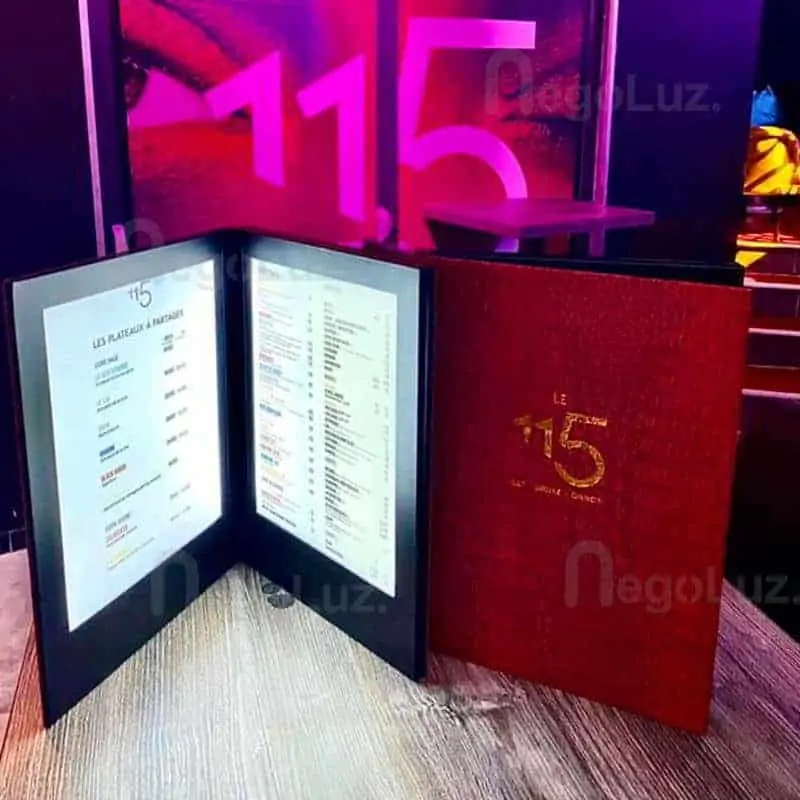Apart from a delicious sauce cooked to perfection, no recipe can guarantee the success of a restaurant. There are no hard and fast rules that will make a restaurant triumphant, but with careful observation and analysis, we can identify the qualities of a good restaurant. From this, we deduce the essential elements of a successful restaurant business. One of these elements is the restaurant menu. The restaurant menu card is not just a table decoration, but it conveys many messages, so restaurant owners try to create a menu that meets the expectations of their guests. Traditionally, the menu is on a card printed according to the menu models that the restaurant owner likes.
In order to understand our topic, we will first look at what a menu card is, then at the different types of menus, and finally at the useful tips for presenting a perfect restaurant menu.
What is a menu card?
A menu card is not only a simple tool that people look at and browse through when they want to see the culinary offerings of a restaurant or any other dining establishment. It’s also an important piece of material that provides more detail about the branding of the restaurant and theme. Most menu cards also go a long way in ensuring that customers will receive excellent gourmet service. In addition, an organized and comprehensive menu card can also help customers become more familiar with the menu of the restaurant. To put it simply, a menu card is a list of dishes offered by a restaurant with optional prices displayed.
The functions of a menu card are as follows:
-
The basis for the success of any gastronomic activity
The menu forms the basis for all activities that take place in the restaurant and throughout the foodservice operation. These activities include suppliers, ingredient purchasing, staffing, production processes, organization of service areas, pricing, interior design, service procedures, etc.
-
Communication device
A menu card communicates to the guests the available dishes and often short and detailed descriptions of each dish. The menu also specifies whether the dishes are spicy or non-spicy, vegetarian or non-vegetarian, etc.
-
An effective selling tool
The menu is above all a sales tool. In catering outlets and gourmet restaurants, they are attractively presented in bright colors on display boards or an original menu holder with images that encourage the consumption of food and drinks. The menu card describes the dishes in an appetizing way, making it easy for customers to choose, helps them locate the dishes they are looking for thanks to the printed photos, promotes the chef’s specials, happy hours, etc.
-
An essential tool to develop your image
The font style, the design, the color, the quality of the menu, the variety of dishes offered, the idea of the presentation of the menu, etc. say a lot about the restaurant’s profile. By looking at the menu, you can evaluate the quality of the kitchen and service staff, the type of equipment used, the infrastructure of the restaurant, the customer profile, etc.
What are the different menu types?
Most of the customers, and even some restaurant or food business owners, may not be aware of the different types of menus that exist for a restaurant. But don’t worry, it’s always a good time to learn something and that’s why we offer you this article where we will start by defining the main menus used in the restaurants.
A la carte menu
This is the menu offered to guests when they take their seats in the restaurant. It is composed of the plates served throughout the year, without great variations in price or variety in the preparations.
In an a la carte menu, the prices of each item are listed separately. This is the most common menu today.
The dishes and beverages offered on an a la carte menu are usually arranged in different groups and sections. This makes a la carte menus particularly easy to read.
The daily menu
It is so called because the dishes that appear on it vary every day depending on the acquisition of ingredients, available products or what the cook has prepared, so that they stand out as the most accessible dishes. They are usually not announced in advance, so that they are unknown until the day of the meal. The menu of the day normally consists of a starter, a main course, a dessert, bread and a drink.
Cyclic menu
This type of menu is often used in restaurants, especially because of the cost-effectiveness it represents. It consists of creating a list of dishes that change with the seasons. In other words, your restaurant will have at least four menus, one for each season of the land. This way, you won’t have to pay high fees for out-of-season products. By using cyclical menus, you ensure that you offer variety to your guests and that you use seasonal ingredients, which avoids increasing costs.
Tasting menu
This menu is composed of many dishes chosen by the restaurant and generally considered as specialties of the house. The purpose of this type of menu is to introduce consumers to a large number of dishes, usually considered to be the house specialties, at a reasonable price, without fear of bad digestion. This allows the introduction of new recipes and the verification of the profitability and popularity of the proposed dishes even before they are included in the fixed menu.
Table d’hôte menu
A table d’hôte menu is a menu that offers a choice of appetizer, main course and dessert, all at a fixed total price. It is the fixed menu that offers the most freedom. In a common table d’hôte configuration, the customer chooses one appetizer from two options, one entrée from two or three options, and one dessert from two options. And the total price does not change. The fact that there are few options and an all-inclusive total price makes it a common menu, but with some variability.
Wedding Menu
A wedding menu card is a special kind of menu card for events that are of great importance for the reception of a unique celebration. It must be an original menu card for an exceptional menu presentation and a successful table decoration, respecting at the same time the established theme.
Tips for presenting the perfect restaurant menu
Whether it’s for a restaurant, cafe, bar or any other food and beverage establishment, displaying your menu is something you’ll certainly engage in, but displaying it properly is another matter entirely. How do you display your menu in a way that is both attractive and informative? How do you present it in a way that will attract customers? With so many options to choose from, the choice can be overwhelming.
Here, we’ll show you how to get the most out of your menu display.
Table menu holder
Choosing a tabletop menu holder is a great alternative for successfully presenting your menu. Perfect for both indoor and outdoor tables, a menu holder could be just what you’re looking for. It protects your menus from hand wear and tear, while remaining easily interchangeable, which has many benefits. We can deduce that a menu holder is also a menu protector.
Regardless of the choice of menu display, it is important to make sure that it fits with the overall style and branding of your establishment. Thus, investing in a lighted menu holder can be a brilliant idea.
The use of LED menu boards can have a great impact on the first impression of your restaurant. Apart from the fact that it can be used as a designer menu protector, it is also a great tool to enhance your restaurant’s brand awareness.
Wall-mounted and illuminated menu holder
If you feel that a wall-mounted sign holder is the best solution for displaying your menu, choosing a wall-mounted lighted menu holder may be a complementary option. Custom-built for menus, the illuminated menu holder is the perfect solution for your restaurant menu display problems. The added benefit of lighting means that your menu is always readable, no matter what time of day it is, whether your establishment is open or closed, and it always catches the eye.


